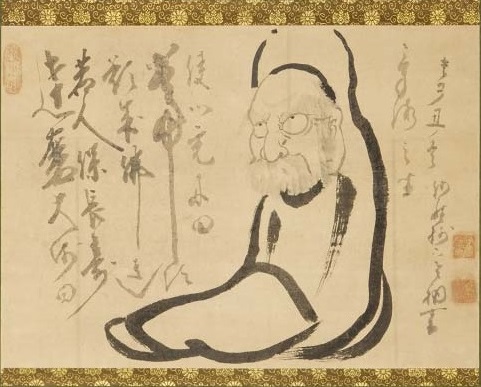白隠慧鶴 Hakuin
Ekaku (1686-1769)
« back
Daruma
1757
Hanging scroll; ink on paper
36 × 50.5 cm

Inscription:
達磨大師曰 若人保長寿 欲成
佛道 常須 使心充丹田 気海之間
Daruma Daishi iwaku, moshi hito chōju
o tamotte Butsudō o jōzen to hosseba, tsune ni
subekaraku kokoro o shite tanden kikai no aida ni
mitashimu beshi
(Great Master Bodhidharma said:
“If you wish to maintain a long
life and attain the way of the Buddha, you should
CONSTANTLY make your heart fill the body's center
and the spirit sea.”)
Signature: Kinoko no ushi no fuyu Sarajukarōnō
sho キノコノ丑ノ冬 沙羅樹下老衲書 (Inscribed by
the Old Monk under the Sala Trees in winter of the
kinoko-ushi year); seals: top left: Kokan'i 顧鑑咦;
bottom right: Hakuin 白隠; Ekaku 慧鶴
With fitted wooden storage box inscribed: Daruma
gasan Hakuin Oshō hitsu 達磨画讃 白隠和尚筆
(Daruma painting and inscription, brushed by Priest
Hakuin)
Hakuin, a great teacher for whom art was above
all a means of conveying religious messages, here
combines thickly brushed, gray-to-black-toned
calligraphy, typical of his later years, with a bold,
simple image of Bodhidharma (in Japanese,
Daruma), founder of Zen Buddhism.1 Bodhidharma
is presented here as a weighted doll that always
returns to a vertical position after it has been
knocked over, symbolizing the resilience of Buddhist
belief; other versions of this image by Hakuin
bear inscriptions including the Japanese word for
such a doll, okiagari-koboshi. The present painting
is similar to a group of works created by Hakuin
in 1757 during a well documented tour of the Ina
Valley in Shinano Province (present-day Nagano
Prefecture). By this time, his fame as an artist was
such that he received advance requests for paintings
at a series of temples and many of these works
are still in their original locations.2
Hovering as so often in Hakuin's work between
humor and forceful expression, the patriarch's
features underline the concentration and commitment
called for by the words of the inscription. As
noted by Audrey Yoshiko Seo, “Hakuin defined and
described the actual practice of meditation more
fully than previous masters,” often using two closely
related terms of Daoist origin that appear in the
inscription on this work: tanden, translated by Seo
as, “the center of energy of the lower abdomen,”
and kikai. The whole term tanden kikai (the body's
center and the spirit sea) appears repeatedly
in Hakuin's writings to denote a physical place,
located three fingers' breadth beneath the navel,
that he considered to be the center of the human
spirit. Hakuin was very fond of enlarging individual
characters for both artistic and educational effect,
as with the word tsune 常 (CONSTANTLY) that
dominates the third line from the left.3
This is a rare example of a dated work by Hakuin.
In Japan (as in China) years within the sixty-year
cycle are rendered as a combination of one of the
jikkan (ten calendar signs) with one of the jūnishi
(twelve zodiac animals); Hakuin makes ushi (ox)
the zodiac animal, but the other word he gives,
apparently kinoko キノコ (mushroom) is not one
of the calendar signs. This might simply be an
example of Hakuin's humor, but in any case he has
something of a reputation for getting his calendar
signs wrong. Since 1757 was an ox year and the
present work resembles others painted during his
tour of the Ina Valley, it can be dated to that year
with some confidence.
1 For discussion of changes in Hakuin's calligraphic style, see Seo
and Addiss 2010, pp. 31 and 152.2 Yoshizawa 2009, pp. 72 – 73 (nos. 86 – 89); no. 87 has a similar inscription
to the present piece (including the outsize tsune), while
nos. 88 and 89 identify the image as okiagari koboshi.3 For tanden and ki, see Seo and Addiss 2010, p. 9.